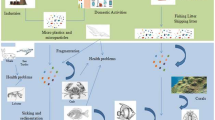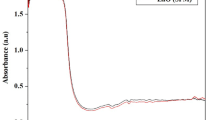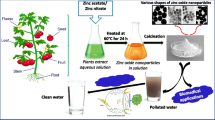Abstract
Fine dust-associated complications related to human health are one of the major issues in the East-Asia region. In the present study, we evaluated anti-inflammatory effect of dieckol in fine dust-stimulated RAW 264.7 macrophage cells and its biological mechanism. The result showed that the exposure of macrophages to fine dust induced the productions of nitric oxide (NO), prostaglandin E2 (PGE2), and the mRNA expression levels of inflammatory mediators such as inducible NO synthase (iNOS) and cyclooxygenase (COX)-2 whereas it was significantly attenuated by the treatment of dieckol. In addition, fine dust increased the pro-inflammatory cytokines such as interleukin (IL)-1β, IL-6, and tumor necrosis factor (TNF)-α that were down-regulated by dieckol. Interestingly, dieckol protected macrophages against cell damages via reducing the fine dust-caused intracellular reactive oxygen species (ROS) generation via induction of superoxide dismutase production as well as the HO-1/Nrf2 signaling activation. In conclusion, dieckol protects RAW 264.7 cells against fine dust-induced inflammation and oxidative stress via inducing anti-inflammatory and antioxidant mechanisms.






Similar content being viewed by others
References
Bekki K, Ito T, Yoshida Y, He C, Arashidani K, He M, Sun G, Zeng Y, Sone H, Kunugita N, Ichinose T (2016) PM2.5 collected in China causes inflammatory and oxidative stress responses in macrophages through the multiple pathways. Environ Toxicol Pharmacol 45:362–369
Cha SM, Cha JD, Jang EJ, Kim GU, Lee KY (2016) Sophoraflavanone G prevents Streptococcus mutans surface antigen I/II-induced production of NO and PGE2 by inhibiting MAPK-mediated pathways in RAW 264.7 macrophages. Arch Oral Biol 68:97–104
Chang MY, Byon SH, Shin HC, Han SE, Kim JY, Byun JY, Lee JD, Park MK (2016) Protective effects of the seaweed phlorotannin polyphenolic compound dieckol on gentamicin-induced damage in auditory hair cells. Int J Pediatr Otorhinolaryngol 83:31–36
Cui Y, Park JY, Wu J, Lee JH, Yang YS, Kang MS, Jung SC, Park JM, Yoo ES, Kim SH, Ahn Jo S, Suk K, Eun SY (2015) Dieckol attenuates microglia-mediated neuronal cell death via ERK, Akt and NADPH oxidase-mediated pathways. Kor J Physiol Pharmacol 19:219–228
Dalgleish AG, O’Byrne K (2006) Inflammation and cancer. In: Dalgleish AG, Haefner B (eds) The Link Between Inflammation and Cancer: Wounds that do not heal. Springer, Boston, pp 1–38.
Fernando IPS, Kim H-S, Sanjeewa KKA, Oh J-Y, Jeon Y-J, Lee WW (2017) Inhibition of inflammatory responses elicited by urban fine dust particles in keratinocytes and macrophages by diphlorethohydroxycarmalol isolated from a brown alga Ishige okamurae. Algae 32:261–273
He M, Ichinose T, Kobayashi M, Arashidani K, Yoshida S, Nishikawa M, Takano H, Sun G, Shibamoto T (2016) Differences in allergic inflammatory responses between urban PM2.5 and fine particle derived from desert-dust in murine lungs. Toxicol Appl Pharmacol 297:41–55
Jeon YJ, Kim HS, Song KS, Han HJ, Park SH, Chang W, Lee MY (2015) Protective effect of dieckol against chemical hypoxia-induced cytotoxicity in primary cultured mouse hepatocytes. Drug Chem Toxicol 38:180–187
Jung WK, Heo SJ, Jeon YJ, Lee CM, Park YM, Byun HG, Choi YH, Park SG, Choi IW (2009) Inhibitory effects and molecular mechanism of dieckol isolated from marine brown alga on COX-2 and iNOS in microglial cells. J Agric Food Chem 57:4439–4446
Kang N-J, Koo D-H, Kang G-J, Han S-C, Lee B-W, Koh Y-S, Hyun J-W, Lee N-H, Ko M-H, Kang H-K (2015) Dieckol, a component of Ecklonia cava, suppresses the production of mdc/ccl22 via down-regulating STAT1 pathway in interferon-γ stimulated HaCaT human keratinocytes. Biomolec Therapeut 23:238
Kim PW (2018) Operating an environmentally sustainable city using fine dust level big data measured at individual elementary schools. Sustain Cities Soc 37:1–6
Kim H-H, Kim H-S, Ko J-Y, Kim C-Y, Lee J-H, Jeon Y-J (2016a) A single-step isolation of useful antioxidant compounds from Ishige okamurae by using centrifugal partition chromatography. Fish Aquat Sci 19:22–27
Kim J, Um M, Yang H, Kim I, Lee C, Kim Y, Yoon M, Kim Y, Kim J, Cho S (2016b) Method development and validation for dieckol in the standardization of phlorotannin preparations. Fish Aquat Sci 19:3
Kim YK, Na KS, Myint AM, Leonard BE (2016c) The role of pro-inflammatory cytokines in neuroinflammation, neurogenesis and the neuroendocrine system in major depression. Prog Neuro-Psychopharmacol Biol Psychiatry 64:277–284
Lee JH, Ko JY, Oh JY, Kim CY, Lee HJ, Kim J, Jeon YJ (2014) Preparative isolation and purification of phlorotannins from Ecklonia cava using centrifugal partition chromatography by one-step. Food Chem 158:433–437
Lee MS, Lee B, Park KE, Utsuki T, Shin T, Oh CW, Kim HR (2015a) Dieckol enhances the expression of antioxidant and detoxifying enzymes by the activation of Nrf2-MAPK signalling pathway in HepG2 cells. Food Chem 174:538–546
Lee YG, Ho C-H, Kim J-H, Kim J (2015b) Quiescence of Asian dust events in South Korea and Japan during 2012 spring: Dust outbreaks and transports. Atmos Environ 114:92–101
Leiro J, Alvarez E, Garcia D, Orallo F (2002) Resveratrol modulates rat macrophage functions. Int Immunopharmacol 2:767–774
Liu Q, Baumgartner J, Zhang Y, Schauer JJ (2016) Source apportionment of Beijing air pollution during a severe winter haze event and associated pro-inflammatory responses in lung epithelial cells. Atmos Environ 126:28–35
Livak KJ, Schmittgen TD (2001) Analysis of relative gene expression data using real-time quantitative PCR and the 2−ΔΔCT method. Methods 25:402–408
Mosmann T (1983) Rapid colorimetric assay for cellular growth and survival: Application to proliferation and cytotoxic assay. J Immunol Methods 65:55–63
Oh G-W, Ko S-C, Lee DH, Heo S-J, Jung W-K (2017) Biological activities and biomedical potential of sea cucumber (Stichopus japonicus): a review. Fish Aquat Sci 20:28–17
Pardo M, Xu F, Qiu X, Zhu T, Rudich Y (2018) Seasonal variations in fine particle composition from Beijing prompt oxidative stress response in mouse lung and liver. Sci Total Environ 626:147–155
Pozzi R, De Berardis B, Paoletti L, Guastadisegni C (2003) Inflammatory mediators induced by coarse (PM2.5-10) and fine (PM2.5) urban air particles in RAW 264.7 cells. Toxicology 183:243–254
Sanjeewa KK, Fernando IP, Kim EA, Ahn G, Jee Y, Jeon YJ (2017) Anti-inflammatory activity of a sulfated polysaccharide isolated from an enzymatic digest of brown seaweed Sargassum horneri in RAW 264.7 cells. Nutr Res Pract 11:3–10
Sinha D, Biswas J, Bishayee A (2013) Nrf2-mediated redox signaling in arsenic carcinogenesis: a review. Arch Toxicol 87:383–396
Su R, Jin X, Zhang W, Li Z, Liu X, Ren J (2017) Particulate matter exposure induces the autophagy of macrophages via oxidative stress-mediated PI3K/AKT/mTOR pathway. Chemosphere 167:444–453
Xiong Q, Ru Q, Chen L, Yue K, Tian X, Ma B, Liu L, Wu R, Xu C, Pi M, Li C (2015) Combined effects of fine particulate matter and lipopolysaccharide on apoptotic responses in NR8383 macrophages. J Toxicol Environ Health A 78:443–452
Zhao Q, Chen H, Yang T, Rui W, Liu F, Zhang F, Zhao Y, Ding W (2016) Direct effects of airborne PM2.5 exposure on macrophage polarizations. Biochim Biophys Acta 1860:2835–2843
Zhao D, Kwon SH, Chun YS, Gu MY, Yang HO (2017) Anti-neuroinflammatory effects of fucoxanthin via inhibition of Akt/NF-κB and MAPKs/AP-1 pathways and activation of PKA/CREB pathway in lipopolysaccharide-activated BV-2 microglial cells. Neurochem Res 42:667–677
Funding
This research was supported by Basic Science Research Program through the National Research Foundation of Korea (NRF) funded by the Ministry of Education (2019R1A6A1A03033553).
Author information
Authors and Affiliations
Corresponding authors
Ethics declarations
Conflicts of interest
The authors declare that they have no conflict of interest.
Additional information
Publisher’s note
Springer Nature remains neutral with regard to jurisdictional claims in published maps and institutional affiliations.
Rights and permissions
About this article
Cite this article
Sanjeewa, K.K.A., Fernando, I.P., Kim, HS. et al. Dieckol: an algal polyphenol attenuates urban fine dust-induced inflammation in RAW 264.7 cells via the activation of anti-inflammatory and antioxidant signaling pathways. J Appl Phycol 32, 2387–2396 (2020). https://doi.org/10.1007/s10811-019-01964-w
Received:
Revised:
Accepted:
Published:
Issue Date:
DOI: https://doi.org/10.1007/s10811-019-01964-w




